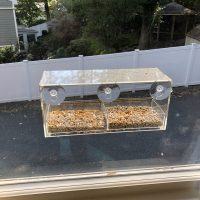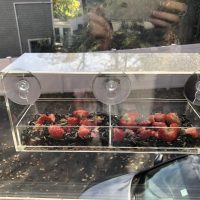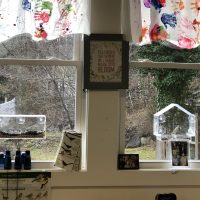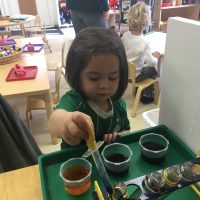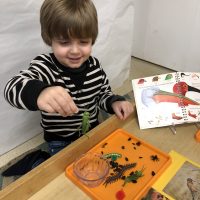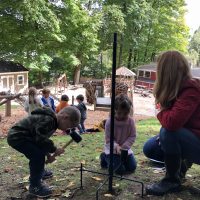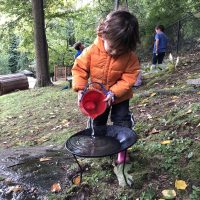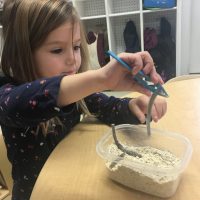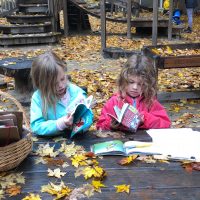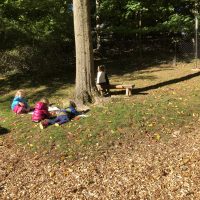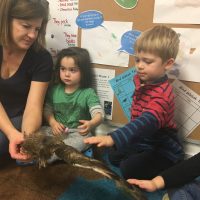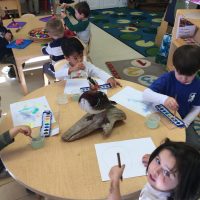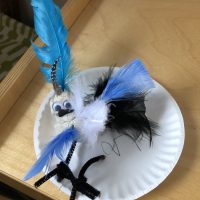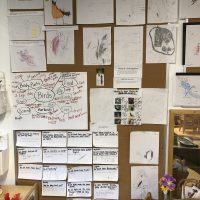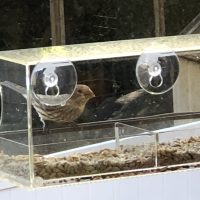We are blessed to have such lovely outdoor spaces at CCNS to enjoy, and the flexibility and creativity of our curriculum to make spending more time outdoors a natural and beneficial extension to our indoor classrooms.
Continue readingThe Birds of CCNS-The Project Approach in Action!
If you walk onto the grounds of CCNS you’ll be delighted to be surrounded by the calls and colors of doves, blue jays, sparrows, and chickadees yet their presence is by no accident. Rather, the return of CCNS’s abundant bird population is due to the interest and work of our students, particularly the threes and fours classes. How and why did so many species of birds decide to return home? Read on to learn about one example of the great rewards of The Project Approach.
A project is a deep study of a topic worth learning more about and is one of the ways we deliver curriculum at CCNS. The Project Approach follows three distinctive phases beginning with the impetus for the project itself.
Phase I: Initiating the Project
Although the Threes and Fours classes studied the same topic for their deep study, it started for two very difference reasons. The Three Class have a class “animal” that differs each year that they use for their attendance tags. This year their tags are birds. Starting the year off there were bird’s nests and stuffed birds and many beautiful non-fiction books on birds in the classroom as provocations. One of their classmates also raises chickens at her home and she and her mom shared their care and their eggs with the class. The children became interested in learning more about the real creatures based on playing with the toys and observing the nests. The Fours Class had two new window bird feeders hung up at eye level in the meeting area full of inviting bird seed. Watching them eagerly they became dismayed after a month of not seeing a single bird at their feeders. Going on a bird watching walk around the grounds revealed a similar fate-they did not see a single bird! Now they were determined to bring the birds back to CCNS.
Phase II: Developing the Project
CCNS has a wonderful relationship with the Darien Nature Center, so both classes worked with their naturalist, Emily. The cornerstone of any project is the questions from the children. Learning how to ask questions and then how to find answers is the real meat of the project and what increases mind brain capacity in children. The Three’s questions focused on the unique body features of birds, while the Four’s were more interested in why they couldn’t see any birds at their school. Emily visited the Threes class and brought some live birds and artifacts with her. They especially liked drawing sketches of the woodland duck she let CCNS borrow to keep in the classrooms for several weeks. The Fours took a trip to the Darien Nature Center to see the birds inside and outside the center and ask their questions. There they noticed several free-standing bird feeders full of active birds, inciting the next phase of their project. Both classes got busy making bird feeders of various kinds to hang around the school, and the Fours invited the owner of Wild Birds Unlimited, Joe, to come to CCNS to give advice on attracting birds to our feeders. Joe helped the Fours class select a bird feeder and all the necessary supplies based on the birds that would be native to our area. The children installed and filled the feeder themselves as well as changed the seeds in their window feeders, even adding dried worms. To the great excitement and sheer joy of all the teachers, parents and children the birds returned to CCNS!! This allowed both the Threes and Fours classes to work together observing, identifying and sharing information about the birds that flocked to our outdoor classroom and each window feeder. They became ornithologists! The Threes class researched and experimented with how the beaks of various birds worked, while the Fours class students each chose a specific bird they had observed and researched its features, food choices and size. They also made costumes based on what they had learned.
Phase III: The Culminating Event
Celebrating learning is a major component of The Project Approach. The Fours became additional experts for the Threes class going in to share what they had learned about each bird with the Threes having time to ask these “experts” questions. They also shared their findings with the Twos class and their own families visited the class to hear their presentations. The Threes class cut out bird shapes from clay and then used their research from photographs and books to paint them with authentic colors and markings to match the bird each clay piece represented.
In true CCNS fashion, the project became a community event with the children in different classes working together, as well as the parents becoming just as excited about seeing the birds back on our playground as the children. Parents shared their knowledge such as with the chickens, their resources by sending in relevant books from home and shared photos of bird sightings around town. The projects have officially come to an end, but the feeders are in place, and being filled just about every three days now that we have hungry doves, woodpeckers, house finches, sparrows, chickadees, blue jays, cardinals and tufted tit mice as regular guests. We even have a very hungry and determined squirrel who has discovered our feeders…perhaps our next project.
What is Big Body Play?
The other day one of our CCNS parents was at the beach watching a couple of boys wrestle around happily. Their babysitter came running over and broke up the tussle warning them to “keep their hands to themselves”. She told us that she really wanted to go over to the woman and explain to her about Big Body Play that we allow at CCNS. So we thought we would share an explanation of why, “keep your hands to yourself” is not always the mantra you want to use with children. This rough and tumble kind of play, coined, “Big Body Play” is a natural activity for children and one that actually teaches many life skills. To read more about it, please click the link to a post on Playfullylearning.me, the blog written by our Educational Director, Dana Gorman, entitled, Rough and Tumble Play- How to Say Yes!
Newsworthy Topic: Learning Through Play

My mailbox has been overflowing with people sending me the links to two articles published recently on learning through play. Many of those people have been the parents of our students sending the link along with effusive “thank yous” for providing their children with such an incredible developmentally appropriate place for learning at CCNS. I wanted to make sure to provide the links to these important articles.
Please read David Kohn’s article featured in the New York Times, Let the Kids Learn Through Play.
As well as an article recently published in Psychology Today by Peter Gray, Early Academic Training Produces Long Term Harm
A third related article from the Washington Post last month by Valerie Strauss, Report Debunks ‘earlier is better’ academic instruction for young children analyzes a report written by Dr. Lillian Katz. This report and the article summarizing it make a distinction between academic goals and intellectual goals. It is helpful to understand that the debate is not simply between play and academic goals. Dr. Katz reports,”An appropriate curriculum for young children is one that includes the focus on supporting children’s in-born intellectual dispositions, their natural inclinations.” She goes on to support teaching basic academic skills within extended project work when children are using these skills to discover areas of interest to them as with this method children are deeply motivated.
CCNS is one of the few schools to extensively use The Project Approach with our preschoolers and Project Practice in our twos program. I received training directly from Dr. Katz herself and continued this training under the guidance of Dr. Judy Helm. The staff at CCNS has been working over the years to refine this practice with our students combining creative and stimulating play opportunities with astute observations of children’s interests. When an interest arises that can be developed in to a project interesting to the children we follow their lead. It is an exciting process that encompasses many facets of learning. One of our projects was featured in the Judy Helm’s newest book, Becoming Young Thinkers:Deep Project Work in the Classroom.
The parents sending me the links to the above articles prefaced their emails with comments such as:
“proof for what you are doing at CCNS”
“I’m so glad my child had the opportunity to learn this way.”
“We are so grateful that the staff of CCNS understands how children learn.”
So if your child is currently enrolled at CCNS, take a moment to feel really good about your decision to send your child to a school that highly values the importance of play combined with intellectual dispositions.
If you are reading this and are not currently enrolled, contact Tracy King at admin@ccnsct.org and give your child the gift of learning through play.



